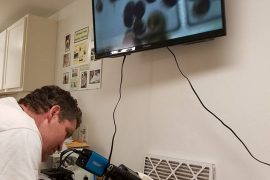Derek A. Applewhite is an associate professor of biology at Reed College in Portland
interview by Sheila G. Miller
In 2017, Applewhite received two large-scale grants—one from the National Science Foundation for $589,000 and another from the National Institutes of Health for nearly $400,000.
Applewhite’s research is about the regulation of the cytoskeleton—that is, the microscopic network that gives a cell its shape. Basically, Applewhite wants to understand how and why the bones and muscles of a cell do what they do. At first blush, that sounds small. But because the cell is the building block of all life, what he studies could have significant meaning for all of us.
Ok, really dumb it down and explain your two grants to us.
I teamed up with my colleague, Anna Ritz, and we wrote the NSF grant together. We’re doing a combination of computational biology and cell biology to uncover some of the basic mechanisms that regulate apical constriction, which is important for making new tissues and organs.
I am the sole principal investigator for the NIH AREA award. The grant focuses on the role of SPECC1L, also known as Split Discs in fruit flies, and its potential in regulating non-muscle myosin II contractility. Mutations to SPECC1L in humans leads to a spectrum of cranial-facial disorders, many of which result in cleft palates. There is a population of cells called neural crest cells that migrate during development to form the jaw and face. Non-muscle myosin II plays a vital role in the way cells migrate and form junctions with other cells. If SPECC1L is regulating non-muscle myosin II, then the mutations that lead to this spectrum of disorders may be uncoupling this regulation.
Why do you use fruit flies to study these topics?
The main reason is because we’re at a small, liberal arts school that only has undergraduate students. They offer a model system and a cell culture system that’s super approachable for someone who is a novice. If you’re teaching future scientists, you want something they can manipulate and work with. It’s not as difficult to work with flies, and fly cells, as compared to mammalian cells.
So unlike at a research university, you include your undergraduate students in this grant-funded research?
Definitely. I have a lab that’s full of students year round, and that number balloons in the summer. With the NSF grant in particular, Anna (Ritz) and I have incorporated our classes into this grant so her class focuses on the computational aspects of that grant in the fall, and my class took those results and incorporated those into the wet lab we are doing with my class now. So there is a very strong integration of my research with my teaching both inform each other.
Undergraduates can be as productive as grad students. They can do real research—real, original, hypothesis-driven research. That’s something a lot of people from bigger schools don’t understand or believe. I don’t give my students, especially those in the lab, a project that I already know the answer to. We are learning together.
What will the ultimate benefits of this research be?
That’s a question of understanding how research is done in general. When you read about a clinical trial, all of that is built on tiny pieces of basic research done in hundreds of labs around the country. People work for decades to find tiny bits of information, and the results build up into something like a clinical trial to test a drug. But it takes decades of tiny little results to be able to build a basis for clinical research. It all stands on the shoulders of basic research and people hammering down and finding out how cells function.








